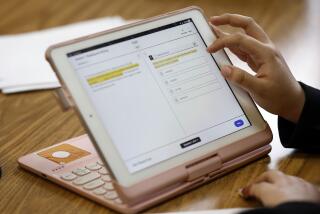Health Survey of Asian Men Finds Need for Insurance, More Doctor Visits
- Share via
SANTA ANA — In the first effort of its kind in Orange County and possibly the state, a local community organization has begun surveying local Asian men in an attempt to understand the complex set of factors affecting their health.
The findings, by the Orange County Asian and Pacific Islander Community Alliance, are preliminary. But they point to some areas of concern, the organizers said.
Of 440 men surveyed since January, only one in 10 of those over age 30 had had a prostate examination in the past year. Prostate cancer is one of the most common forms of cancer in men and most curable if detected early.
Asian men are more likely than their Anglo counterparts to lack health insurance, and older Asian men are more likely to die of cancer than heart disease, the leading killer of white, African American and Latino men in the same age group.
Nearly half of those surveyed cited a lack of insurance as the primary barrier to health care. Language barriers came in second at 35%. A majority of the subjects were visitors to the Asian Health Center, a low-cost clinic that serves mainly the Vietnamese community.
Aversion to doctors is not the exclusive domain of Asian American men. Research shows that men in general are far less likely to regularly visit the doctor than women.
But such attitudes, combined with low rates of health insurance coverage and a general lack of medical data on Asian American men, make this segment of the population particularly vulnerable to health problems, experts say.
Organizers concede that their initial data, gathered since the beginning of the year, are skewed because clinic patients are more likely than others to lack health insurance. Such patients also are less likely to seek care because of costs.
However, even among clinic patients, the men stand out for their absence. Of the nearly 3,000 who use the health center, about 30% are men.
“For API [Asian and Pacific Islander] males, the culture is a definite barrier for positive health behavior,” said Jason Lacsamana, a program coordinator for the health alliance. “In Asian culture, the man is supposed to be stoic. They work long hours, support their families. To show weakness is not an option for them.”
Co Thi Trinh is all too familiar with that. The 37-year-old mother of two from Westminster was at the Asian Health Center for her annual checkup and got a clean bill of health. Asked how her 52-year-old husband was, she shook her head.
“He’s always sick,” Trinh said through a translator. Still, he goes to see the doctor only when “I bother and remind him.”
Trinh’s husband has health insurance. But for many Asian men, it is a foreign concept, said Linn Cook, alliance program manager. To immigrants from countries without such a system, “it doesn’t make sense to pay for medical treatment when you are not ill.”
Asian and Pacific Islanders in general, and men in particular, lack health insurance at higher rates than the national average. In California, 24% of Asian and Pacific Islander adult men have no health insurance, according to UCLA’s Center for Health Policy Research, which analyzes federal census health surveys. The rate is higher for Latinos--48%--and African Americans--28%. But it is lower for Anglos, of whom about 17% lack insurance.
But Ninez Ponce, a senior researcher at the center, doubts the numbers. She believes the Asian and Pacific Islander population is undercounted because such surveys are conducted in English and Spanish, but not in their native languages.
“It may be true of the English-speaking Asian population, but not the whole population,” she said. “We know the need is there; these numbers may be masking a lot of the needs.”
Cost also is a barrier.
Frank Do, 24, is a nursing student who works part time at a bookstore. He visits the Asian Health Center for regular checkups as part of his professional training, but should he become ill, he is not sure what he would do.
“Even if I worked full time, I couldn’t afford to buy insurance,” said Do, who helps his older sister support his parents financially.
Wendy Yoo, chairman of the Orange County Korean Citizenship League, estimates that more than half of local Korean American men and their families lack health insurance. She said that many Korean immigrants own their own businesses and see health insurance for themselves or their employees as a financial burden.
“It is simply very hard for them to afford it,” she said.
Asian women are more likely to get health care because of government-subsidized programs like Medi-Cal and Healthy Families, health experts said. Moreover, growing mainstream awareness and funding for women’s health issues such as breast and cervical cancer have prompted Asian women to get treatment, health experts said.
The disparity of health conditions along ethnic lines has emerged as a major public issue in recent years as medical professionals recognize the need to tailor health programs in an increasingly diverse society.
More to Read
Sign up for Essential California
The most important California stories and recommendations in your inbox every morning.
You may occasionally receive promotional content from the Los Angeles Times.









